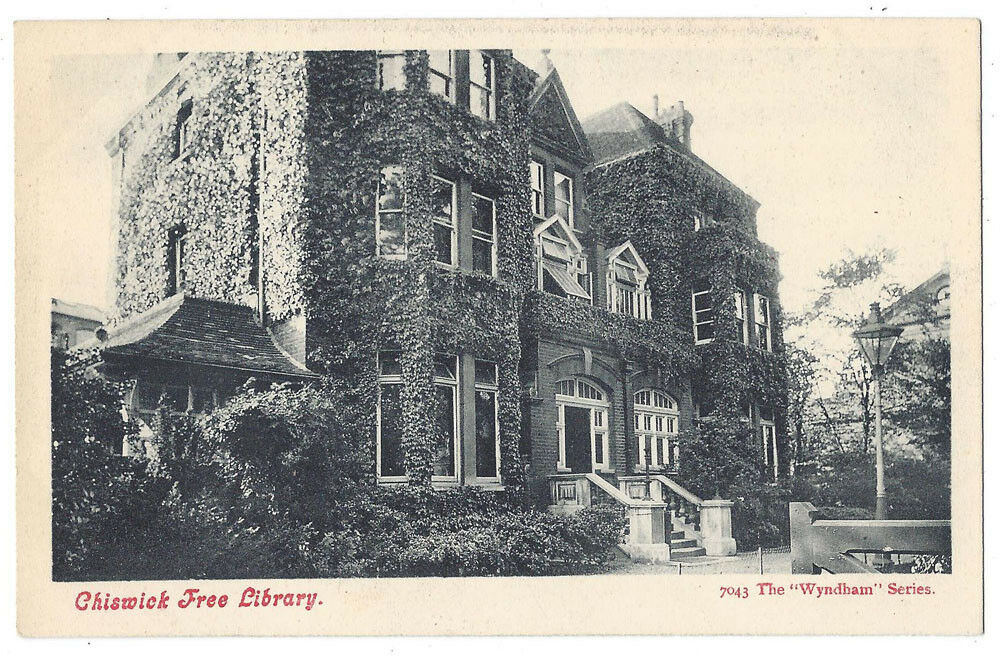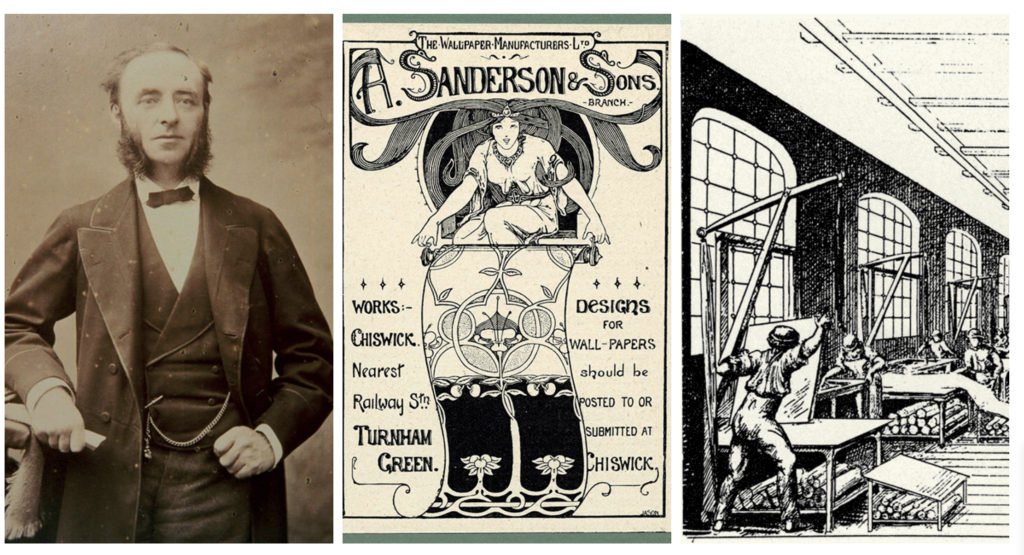
1. Chiswick Library: Sanderson’s Jubilee gift and the move to Duke’s Avenue
Image: postcard from the collection of Torin Douglas
From Brentford & Chiswick Local History Journal (1987)
In 1897 Chiswick Library was facing the worst crisis of its short life. The library service had started in the house on the corner of Duke Road and Bourne Place in 1890 and each year it had become steadily busier and more crowded. Borrowers had to queue on the stairs leading to the lending library on the first floor to change their books, and readers wanting to look at the newspapers and magazines were crammed into two small rooms on the ground floor.
….. News broke in October 1897 of ‘one of the noblest gifts the parish had ever received’. Mr Arthur Sanderson had written to the Council offering to ‘give our house, Number One Duke’s Avenue to the parish for use as a public library. We thought it would have been a fitting way of celebrating the Jubilee.’ Although the parish had held celebratory meals and festivities to mark Queen Victoria’s 60 years on the throne, there had been no permanent memorial, as in many other areas, so perhaps the Sandersons felt this would redress the balance.
The Council’s legal experts immediately opened negotiations with the Duke of Devonshire and Mr Watts (the Sandersons’ neighbours) and eventually a compromise was agreed that would allow the library to move into the Duke’s Avenue house but, should it ever move out, the building must immediately revert to a private house.
2. Work And Colour: Sanderson And Chiswick 1879-1928
From Brentford & Chiswick Local History Journal (2001)
By Freddie Launert, the company archivist for Sanderson & Co, by whose kind permission this image is reproduced.
In 1879 Chiswick became the home of the wallpaper manufacturing works of Arthur Sanderson & Sons. In its heyday over a thousand people were employed on the site, engaged in the various processes involved in the production of hand and machine-printed wall coverings, and the firm was one of the largest employers in the area. Several of the old factory buildings still survive in Chiswick today, but the firm no longer operates there. This article is about the story of Sanderson in Chiswick: the establishment of the business, its growth, its successes, and the dramatic demise of the factory.

See more about the history of Sanderson on its website (image above)
See the link between Sanderson and William Morris in Chiswick
3. C.F.A. Voysey: Voysey House, 1902
From Chiswick Timeline: A History in Art and Maps
In 1879 Arthur Sanderson opened his wallpaper manufacturing works in Chiswick, on the site of a former barracks. This is currently the building, then known as Devonshire Works, that comprises Foxlows and the Barley Mow Business Centre. If you look up from the Barley Mow Passage you can still see the Sanderson’s name writ large. Even the little roadway that goes from the passage to the High Road is still called Sanderson Lane.
In 1902 the building now known as Voysey House was completed. Designed by Charles Voysey (1857–1941), it was added to the other side of the passage, originally connected to the main factory at Devonshire Works via a footbridge, clearly visible in our image. Voysey, briefly a Bedford Park resident who had designed wallpapers for Sandersons in the 1880s, was an architect, and a furniture and textile designer who favoured a simple Arts and Crafts style. This is his only industrial building, though he went on to design several country houses. There is another Voysey house in Chiswick, a private residence on South Parade.
Sanderson set to return to Voysey House in Chiswick – The Chiswick Calendar, March 2024
4. Alain-Fournier: Sandersons and Towards the Lost Domain
Timeline Tales: Alain-Fournier, The Great Gatsby and a party in Chiswick
A key scene in Le Grand Meaulnes was inspired by a works fete at Sanderson & Sons in Chiswick where, aged 19, Alain-Fournier worked as a translator. Towards the Lost Domain: Letters from London 1905 is a translation by WJ Strachan of Fournier’s letters which he wrote home during the time he stayed in Chiswick.
5. Ralph Miliband and Chiswick Library
Ralph Miliband, Socialist Intellectual (1924-1994) – Leo Panitch, Socialist Register
Ralph Miliband, the Marxist sociologist and father of the Labour politicians David and Ed Miliband, spent many hours studying in Chiswick Public Library after settling here as a 17-year-old refugee in May 1940, in the early days of World War II. Leo Panitch wrote:
“Spending as much time as possible in the Chiswick Public Library, where he read the Daily Worker as well as other morning papers, and Labour Monthly as well as Keesing’s Archives, he came across the writings of Harold Laski. Seeing that he was connected with the London School of Economics and Political Science (of which Ralph had heretofore never heard), he applied to study with him there and was, astonishingly enough, admitted. Laski’s impact was immediate and enduring: ‘I was quite dazzled, as a 17-year old student, by his scholarship, his wit, his extraordinary generosity to students, and his familiarity with the great and the mighty.’”
Ralph and his father Sam had escaped from Belgium on the last boat to leave before the arrival of the Nazis, and made their living by clearing furniture from bombed Chiswick houses during the Blitz. Thanks to Matt Myers for drawing our attention to this fascinating Chiswick connection.
A Vicarage In The Blitz – Chiswick in WW2
6. Chiswick Library today
Chiswick Library today is run by Hounslow Council and is still located at 1 Duke’s Avenue. The building was extended following the donation by Arthur Sanderson . It regularly hosts the final event in the Chiswick Book Festival.
You can read about its services and opening times here.
Chiswick Timeline Writers Trail
Read more stories via the Writers Tales page.
The Chiswick Timeline of Writers & Books lists almost 500 writers who have written a book and lived in Chiswick W4, or written books about the area. See A Quick Guide.
